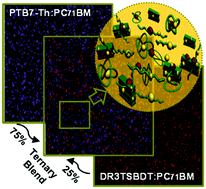Ternary organic solar cells (OSCs), with a simple structure, can be easily adopted as sub-cells in a tandem design, thereby further enhancing the power conversion efficiency (PCE). Considering the potential to surpass the theoretical PCE limit in OSCs, we incorporated a benzo[1,2-b;4,5-b′]dithiophene-based small molecule into a poly(4,8-bis(5-(2-ethylhexyl)thiophen-2-yl)benzo[1,2-b;4,5-b′]dithiophene-2,6-diyl-alt-(4-(2-ethylhexyl)-3-fluorothieno[3,4-b]thiophene-)-2-carboxylate-2-6-diyl):[6,6]-phenyl-C71-butyric acid methyl ester host system. A hitherto unrealized PCE of 12.1% was achieved at the optimized composition of the ternary blend. The ternary blend surprisingly had a face-on and edge-on co-existent texture, which is far better than that of the face-on orientated host film. To the best of our knowledge, this intriguing result refutes for the first time a general paradigm that high-performance OSCs are unambiguously linked to face-on structures. Therefore, our study provides a new platform for refining the theoretical underpinning of multiple blending OSCs.
